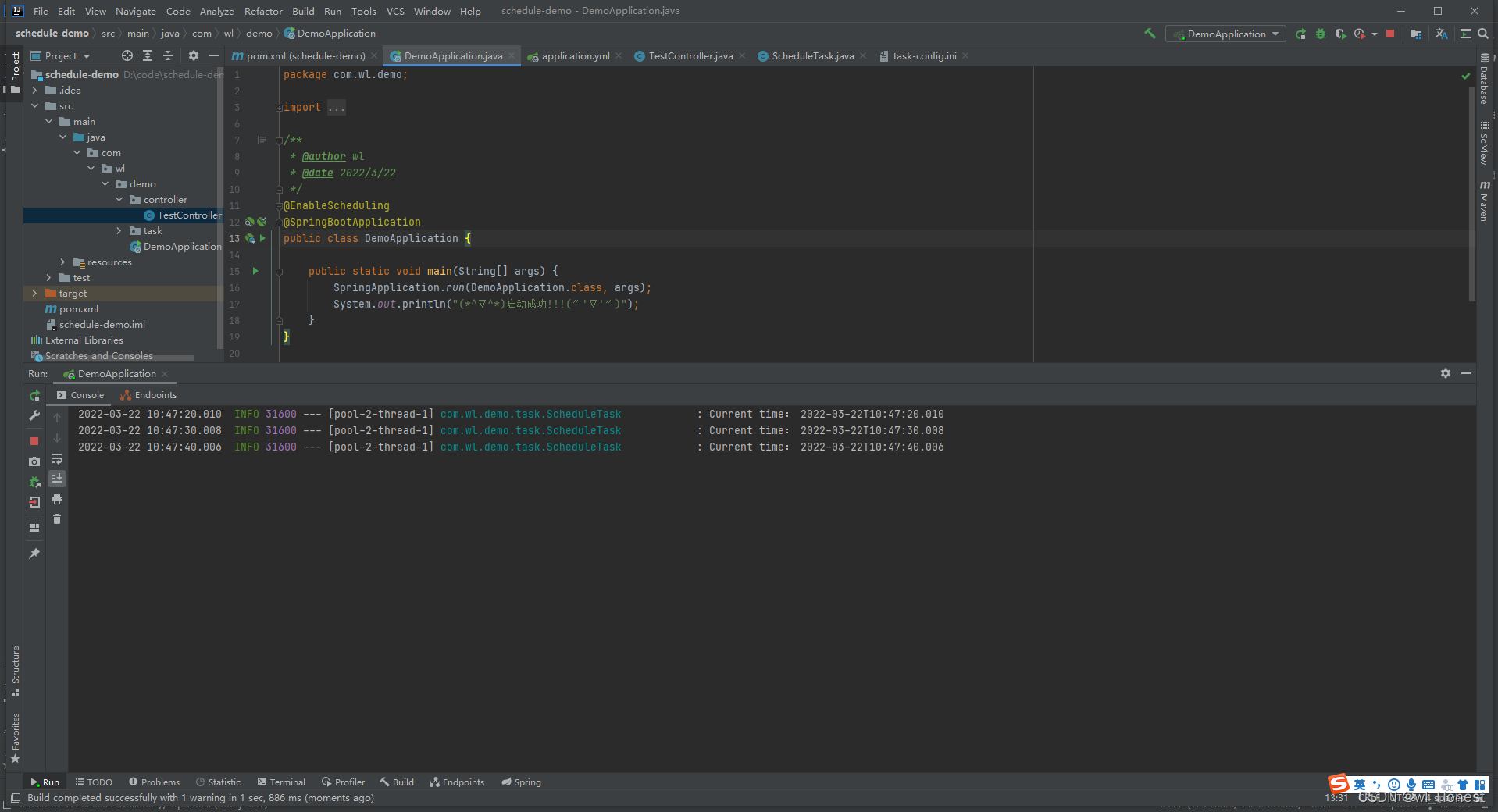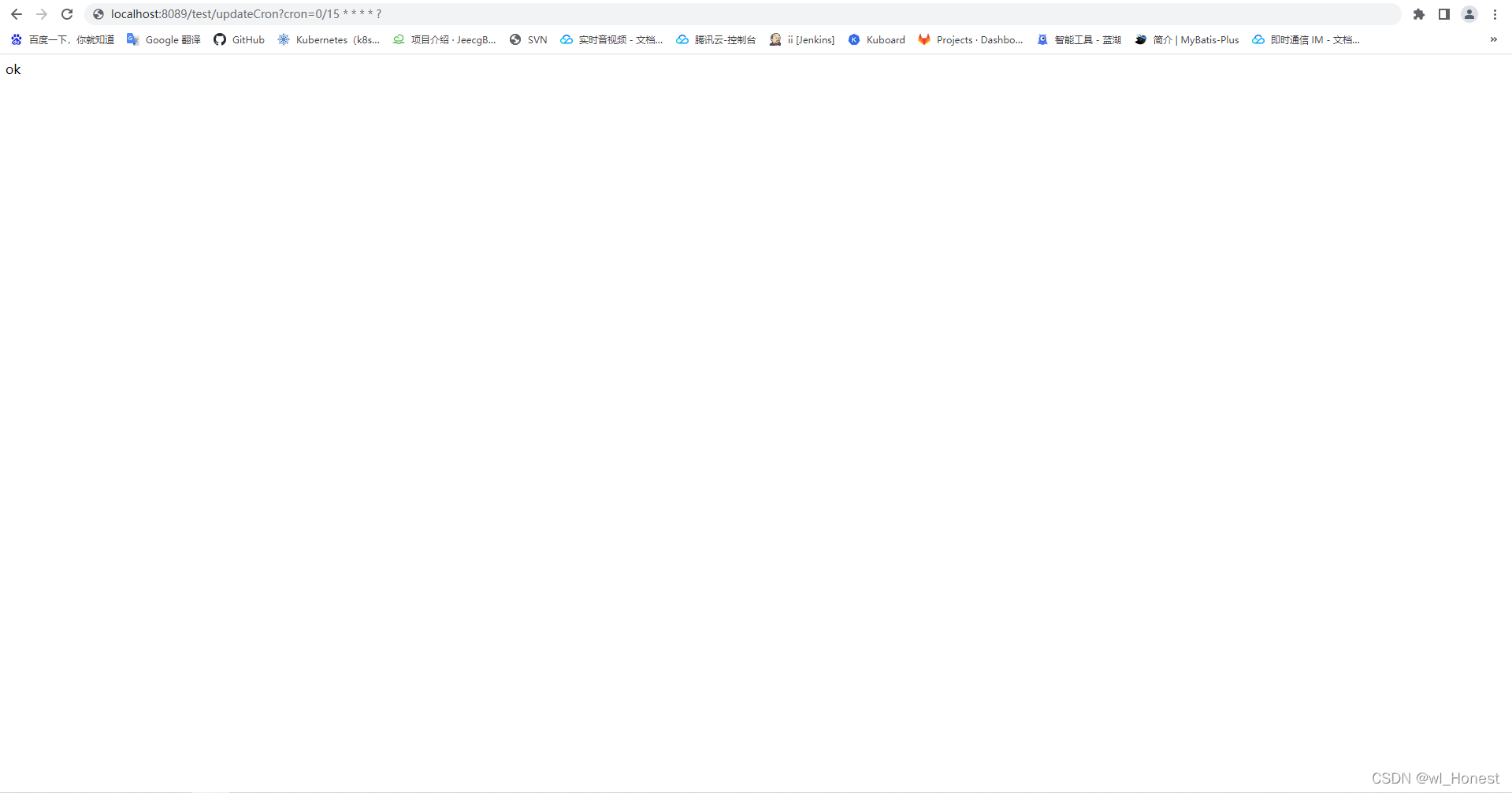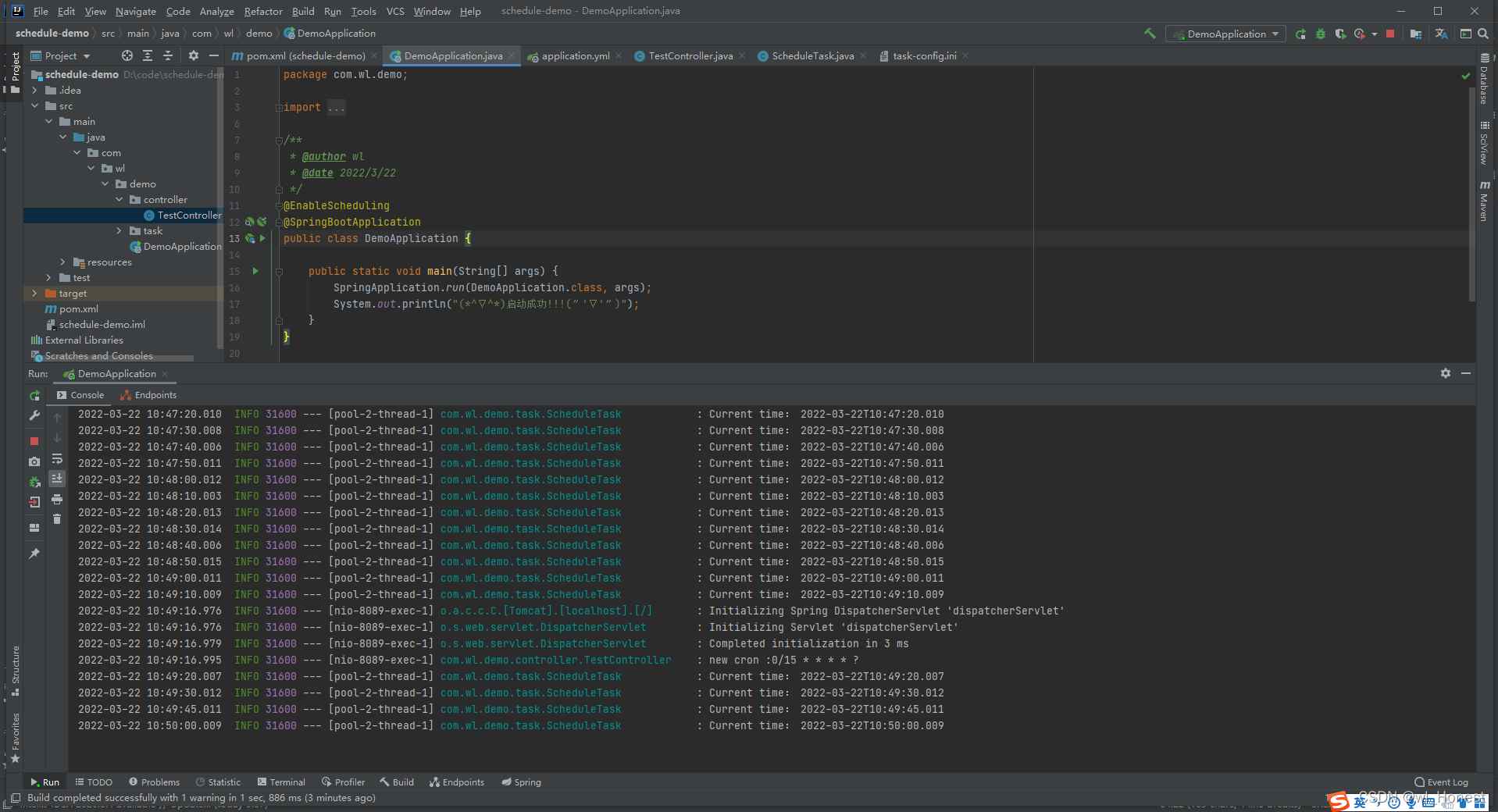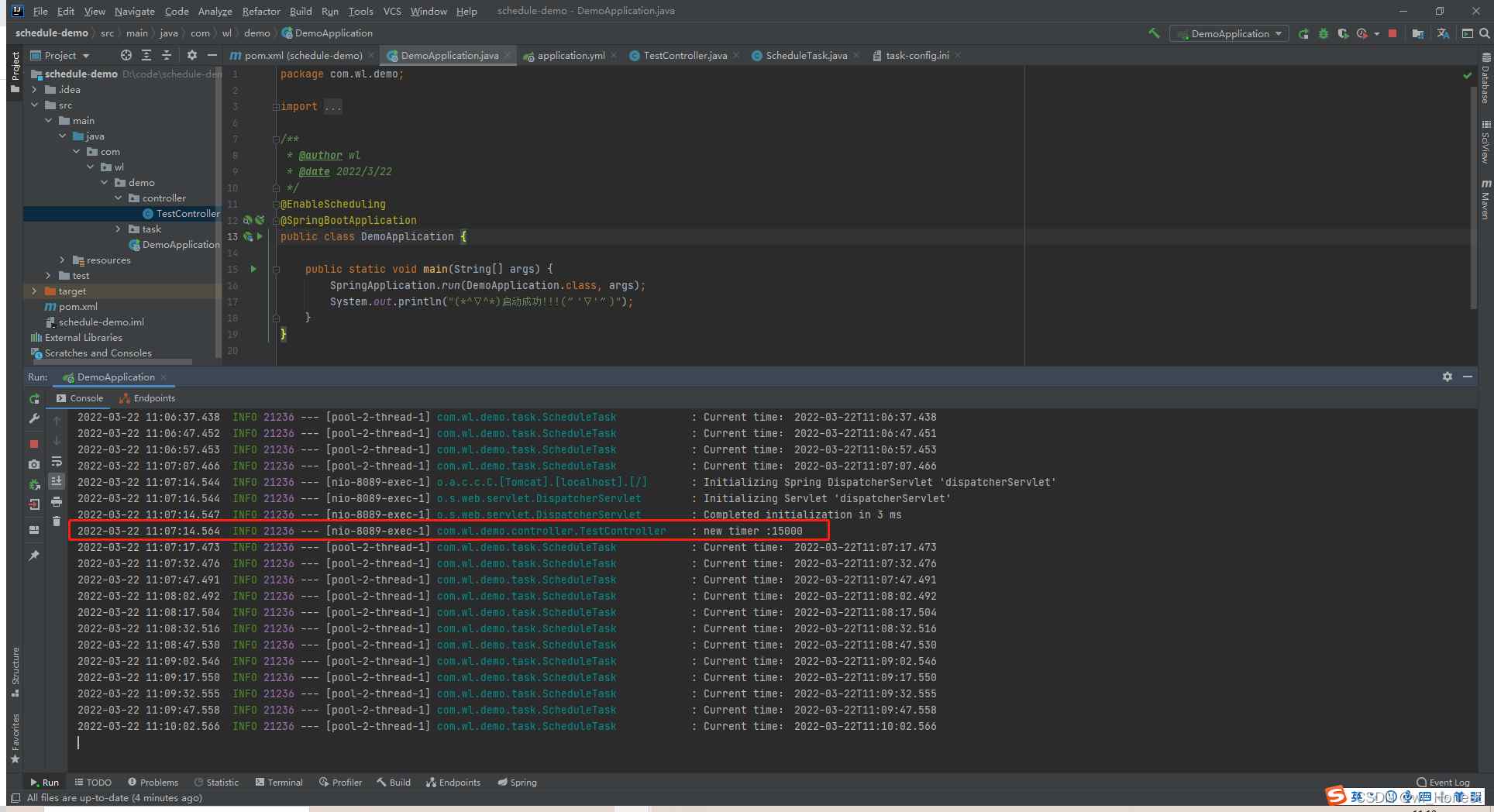SpringBoot设置动态定时任务的方法详解
之前写过文章记录怎么在SpringBoot项目中简单使用定时任务,不过由于要借助cron表达式且都提前定义好放在配置文件里,不能在项目运行中动态修改任务执行时间,实在不太灵活。
经过网上搜索学习后,特此记录如何在SpringBoot项目中实现动态定时任务。
因为只是一个demo,所以只引入了需要的依赖:
<dependencies>
<dependency>
<groupId>org.springframework.boot</groupId>
<artifactId>spring-boot-starter-web</artifactId>
</dependency>
<dependency>
<groupId>org.springframework.boot</groupId>
<artifactId>spring-boot-starter-log4j2</artifactId>
<optional>true</optional>
</dependency>
<!-- spring boot 2.3版本后,如果需要使用校验,需手动导入validation包-->
<dependency>
<groupId>org.springframework.boot</groupId>
<artifactId>spring-boot-starter-validation</artifactId>
</dependency>
<dependency>
<groupId>org.projectlombok</groupId>
<artifactId>lombok</artifactId>
<optional>true</optional>
</dependency>
</dependencies>启动类:
package com.wl.demo;
import org.springframework.boot.SpringApplication;
import org.springframework.boot.autoconfigure.SpringBootApplication;
import org.springframework.scheduling.annotation.EnableScheduling;
/**
* @author wl
* @date 2022/3/22
*/
@EnableScheduling
@SpringBootApplication
public class DemoApplication {
public static void main(String[] args) {
SpringApplication.run(DemoApplication.class, args);
System.out.println("(*^▽^*)启动成功!!!(〃'▽'〃)");
}
}配置文件application.yml,只定义了服务端口:
server:
port: 8089定时任务执行时间配置文件:task-config.ini:
printTime.cron=0/10 * * * * ?
定时任务执行类:
package com.wl.demo.task;
import lombok.Data;
import lombok.extern.slf4j.Slf4j;
import org.springframework.beans.factory.annotation.Value;
import org.springframework.context.annotation.PropertySource;
import org.springframework.scheduling.Trigger;
import org.springframework.scheduling.TriggerContext;
import org.springframework.scheduling.annotation.SchedulingConfigurer;
import org.springframework.scheduling.config.ScheduledTaskRegistrar;
import org.springframework.scheduling.support.CronTrigger;
import org.springframework.stereotype.Component;
import java.time.LocalDateTime;
import java.util.Date;
/**
* 定时任务
* @author wl
* @date 2022/3/22
*/
@Data
@Slf4j
@Component
@PropertySource("classpath:/task-config.ini")
public class ScheduleTask implements SchedulingConfigurer {
@Value("${printTime.cron}")
private String cron;
@Override
public void configureTasks(ScheduledTaskRegistrar taskRegistrar) {
// 动态使用cron表达式设置循环间隔
taskRegistrar.addTriggerTask(new Runnable() {
@Override
public void run() {
log.info("Current time: {}", LocalDateTime.now());
}
}, new Trigger() {
@Override
public Date nextExecutionTime(TriggerContext triggerContext) {
// 使用CronTrigger触发器,可动态修改cron表达式来操作循环规则
CronTrigger cronTrigger = new CronTrigger(cron);
Date nextExecutionTime = cronTrigger.nextExecutionTime(triggerContext);
return nextExecutionTime;
}
});
}
}编写一个接口,使得可以通过调用接口动态修改该定时任务的执行时间:
package com.wl.demo.controller;
import com.wl.demo.task.ScheduleTask;
import lombok.extern.slf4j.Slf4j;
import org.springframework.beans.factory.annotation.Autowired;
import org.springframework.web.bind.annotation.GetMapping;
import org.springframework.web.bind.annotation.RequestMapping;
import org.springframework.web.bind.annotation.RestController;
/**
* @author wl
* @date 2022/3/22
*/
@Slf4j
@RestController
@RequestMapping("/test")
public class TestController {
private final ScheduleTask scheduleTask;
@Autowired
public TestController(ScheduleTask scheduleTask) {
this.scheduleTask = scheduleTask;
}
@GetMapping("/updateCron")
public String updateCron(String cron) {
log.info("new cron :{}", cron);
scheduleTask.setCron(cron);
return "ok";
}
}启动项目,可以看到任务每10秒执行一次:

访问接口,传入请求参数cron表达式,将定时任务修改为15秒执行一次:

可以看到任务变成了15秒执行一次

除了上面的借助cron表达式的方法,还有另一种触发器,区别于CronTrigger触发器,该触发器可随意设置循环间隔时间,不像cron表达式只能定义小于等于间隔59秒。
package com.wl.demo.task;
import lombok.Data;
import lombok.extern.slf4j.Slf4j;
import org.springframework.beans.factory.annotation.Value;
import org.springframework.context.annotation.PropertySource;
import org.springframework.scheduling.Trigger;
import org.springframework.scheduling.TriggerContext;
import org.springframework.scheduling.annotation.SchedulingConfigurer;
import org.springframework.scheduling.config.ScheduledTaskRegistrar;
import org.springframework.scheduling.support.CronTrigger;
import org.springframework.scheduling.support.PeriodicTrigger;
import org.springframework.stereotype.Component;
import java.time.LocalDateTime;
import java.util.Date;
/**
* 定时任务
* @author wl
* @date 2022/3/22
*/
@Data
@Slf4j
@Component
@PropertySource("classpath:/task-config.ini")
public class ScheduleTask implements SchedulingConfigurer {
@Value("${printTime.cron}")
private String cron;
private Long timer = 10000L;
@Override
public void configureTasks(ScheduledTaskRegistrar taskRegistrar) {
// 动态使用cron表达式设置循环间隔
taskRegistrar.addTriggerTask(new Runnable() {
@Override
public void run() {
log.info("Current time: {}", LocalDateTime.now());
}
}, new Trigger() {
@Override
public Date nextExecutionTime(TriggerContext triggerContext) {
// 使用CronTrigger触发器,可动态修改cron表达式来操作循环规则
// CronTrigger cronTrigger = new CronTrigger(cron);
// Date nextExecutionTime = cronTrigger.nextExecutionTime(triggerContext);
// 使用不同的触发器,为设置循环时间的关键,区别于CronTrigger触发器,该触发器可随意设置循环间隔时间,单位为毫秒
PeriodicTrigger periodicTrigger = new PeriodicTrigger(timer);
Date nextExecutionTime = periodicTrigger.nextExecutionTime(triggerContext);
return nextExecutionTime;
}
});
}
}增加一个修改时间的接口:
package com.wl.demo.controller;
import com.wl.demo.task.ScheduleTask;
import lombok.extern.slf4j.Slf4j;
import org.springframework.beans.factory.annotation.Autowired;
import org.springframework.web.bind.annotation.GetMapping;
import org.springframework.web.bind.annotation.RequestMapping;
import org.springframework.web.bind.annotation.RestController;
/**
* @author wl
* @date 2022/3/22
*/
@Slf4j
@RestController
@RequestMapping("/test")
public class TestController {
private final ScheduleTask scheduleTask;
@Autowired
public TestController(ScheduleTask scheduleTask) {
this.scheduleTask = scheduleTask;
}
@GetMapping("/updateCron")
public String updateCron(String cron) {
log.info("new cron :{}", cron);
scheduleTask.setCron(cron);
return "ok";
}
@GetMapping("/updateTimer")
public String updateTimer(Long timer) {
log.info("new timer :{}", timer);
scheduleTask.setTimer(timer);
return "ok";
}
}测试结果:

到此这篇关于SpringBoot设置动态定时任务的方法详解的文章就介绍到这了,更多相关SpringBoot设置动态定时任务内容请搜索编程学习网以前的文章希望大家以后多多支持编程学习网!
